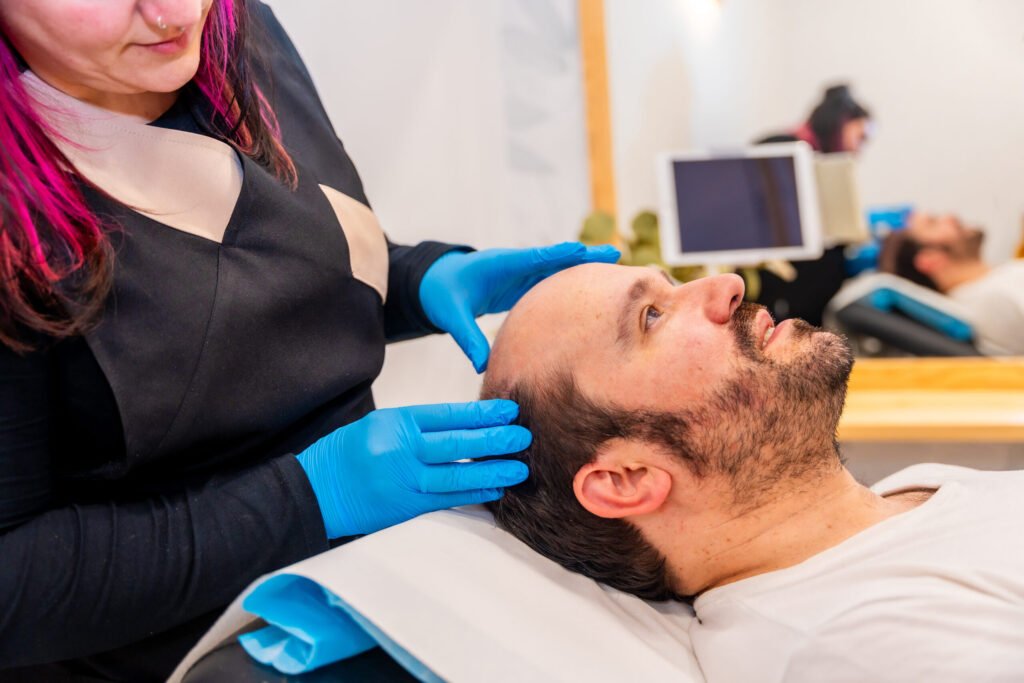Hair loss affects up to 70% of men by age 50, and choosing the right medical professional to evaluate and treat your hair loss is a crucial step toward effective, long-term solutions. With so many clinics and providers offering treatments—from prescription medications to hair transplants and regenerative therapies—it can be overwhelming to know where to start.
This guide will walk you through how to choose the right hair loss specialist—whether you’re dealing with early thinning or more advanced balding.
🧬 Why Specialist Care Matters
Hair loss isn’t just cosmetic. It can be a sign of underlying hormonal, autoimmune, or genetic conditions. A hair loss specialist does more than treat the symptom—they identify the root cause and recommend evidence-based solutions tailored to your specific needs.
Without proper diagnosis, you risk:
- Wasting time and money on ineffective treatments
- Aggravating the condition
- Missing early intervention opportunities
🔍 Step 1: Understand the Types of Hair Loss Professionals
1. Board-Certified Dermatologist
- Trained to diagnose and treat skin and scalp disorders
- Experts in alopecia, including androgenetic alopecia, alopecia areata, and scarring alopecias
- Can prescribe medications like finasteride and minoxidil, and offer diagnostic scalp biopsies
✅ Best for: Accurate diagnosis and medically supervised treatment
2. Hair Restoration Surgeon (MD or DO)
- Specializes in surgical solutions like hair transplants (FUE or FUT)
- Often has dermatology or plastic surgery background
- May also offer PRP, microneedling, and laser therapies
✅ Best for: Advanced hair loss needing transplant or regenerative therapy
3. Trichologist
- Specialist in hair and scalp disorders (not a medical doctor)
- Focuses on non-surgical hair loss evaluation, scalp health, and topical solutions
✅ Best for: Supplementary care, especially for mild cases or scalp support
📋 Step 2: Evaluate Their Qualifications
When choosing a hair loss specialist, verify:
- ✅ Medical degree (MD or DO) from an accredited institution
- ✅ Board certification in dermatology, plastic surgery, or hair restoration surgery
- ✅ Memberships in relevant associations (e.g., American Academy of Dermatology, ISHRS)
- ✅ Years of experience treating male pattern hair loss
- ✅ Track record of treating cases similar to yours
💡 Tip: Ask if the doctor has published research or presented at hair restoration conferences.
🧪 Step 3: Look for a Comprehensive Diagnostic Approach
A good specialist won’t jump straight to treatment. They will first:
- Take a detailed medical and family history
- Perform a scalp exam to assess hair thinning patterns
- Use trichoscopy (scalp magnification) to evaluate follicular health
- Possibly order blood tests to check for:
- Thyroid issues
- Iron deficiency
- Vitamin D or B12 levels
- Hormonal imbalances (e.g., testosterone, DHT)
🧠 A scalp biopsy may be done if scarring alopecia is suspected.
💉 Step 4: Assess Their Range of Treatment Options
A top-tier specialist should offer both non-surgical and surgical solutions tailored to your condition and preferences.
Non-Surgical Options:
- Oral finasteride or topical finasteride
- Topical minoxidil or oral minoxidil
- PRP (Platelet-Rich Plasma) therapy
- Low-Level Laser Therapy (LLLT)
- Microneedling
- Nutritional and lifestyle counseling
Surgical Options:
- Follicular Unit Extraction (FUE)
- Follicular Unit Transplantation (FUT)
- Scalp micropigmentation (SMP)
💬 Ask: “How do you decide when a patient is a good candidate for a hair transplant vs medical therapy?”
🏥 Step 5: Check Facility Standards and Technology
A reputable clinic should have:
- A clean, licensed, and accredited facility
- Modern diagnostic tools (e.g., trichoscopes, digital imaging)
- Transparent protocols for hygiene and infection control
- A knowledgeable support team (nurses, techs, patient coordinators)
⚠️ Be cautious of clinics offering “miracle cures,” non-medical staff pushing treatments, or refusing to discuss risks.
💬 Step 6: Ask These Key Questions in Your Consultation
Here’s what to ask when interviewing a potential specialist:
- What is the likely cause of my hair loss?
- What stage am I currently in, and how can we prevent progression?
- What treatment options are best for my situation?
- What are the risks and side effects of each treatment?
- How long will it take to see results?
- Do you have before-and-after photos of patients like me?
- What are the long-term maintenance expectations and costs?
💰 Step 7: Understand Pricing and Insurance
Most hair loss treatments are not covered by insurance, especially cosmetic procedures like transplants or PRP. However, some diagnostic tests or medications may be partially reimbursable.
Make sure to get:
- A transparent pricing breakdown
- Financing options (if applicable)
- A long-term plan to assess total cost vs ongoing benefits
🧑⚕️ Red Flags to Watch For
❌ Guarantees of “permanent results”
❌ Clinics without a licensed MD/DO
❌ Pushy sales tactics with no medical explanation
❌ Reliance on a single treatment for every patient
❌ No medical exam before suggesting solutions
📌 Final Thoughts
Finding the right hair loss specialist is a medical decision, not a cosmetic one. Prioritize credentials, diagnostic depth, treatment options, and long-term care over flashy marketing or quick fixes. The ideal doctor will help you preserve your hair, regain your confidence, and make informed decisions based on science—not hype.




